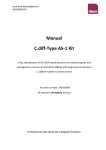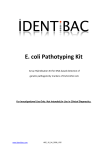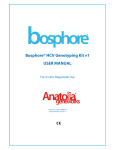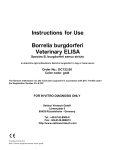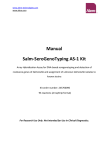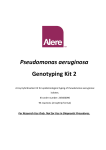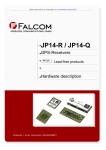Download Influenza A Genotyping Kit
Transcript
www.clondiag.com www.alere-technologies.com Influenza A Genotyping Kit The Influenza A Genotyping Kit is an Array Hybridisation Kit for Influenza A virus H- and N-subtyping. Kit order number: 245300096 96 reactions (ArrayStrip format) For Research Use Only. Not for Use in Diagnostic Procedures. www.clondiag.com www.alere-technologies.com Content BACKGROUND ................................................................................................................................. 4 GENERAL INSTRUCTIONS FOR USE.................................................................................................. 5 Intended Use ................................................................................................................................ 5 Test Principle................................................................................................................................ 5 Specifications ............................................................................................................................... 6 Technical Support ........................................................................................................................ 6 Safety Precautions ....................................................................................................................... 6 Material Safety Data Sheets (MSDS)............................................................................................ 6 Shipping Precautions.................................................................................................................... 7 REAGENTS AND DEVICES ................................................................................................................. 8 Kit Components, Storage and Stability ........................................................................................ 8 RNA Reverse Transcription, Amplification and Labelling ......................................................... 8 Hybridisation and Detection..................................................................................................... 8 Components Required but not Provided by Alere....................................................................... 9 INSTRUMENTATION AND SOFTWARE ........................................................................................... 10 PROTOCOL ..................................................................................................................................... 11 Viral RNA and RT-PCR................................................................................................................. 11 RNA Preparation (RNase-free conditions).............................................................................. 11 RT-PCR (RNase-free conditions) ............................................................................................. 11 Hybridisation .............................................................................................................................. 13 General Remarks - Handling of Arrays ................................................................................... 13 General Remarks - Handling of Liquids .................................................................................. 14 General Remarks - The Substrate (Precipitating Dye) D1 ...................................................... 14 General Remarks - Thermoshakers ........................................................................................ 15 Preparation and Denaturation of the Hybridisation Mixture ................................................ 15 Pre-Washing of the Arrays...................................................................................................... 16 Hybridisation .......................................................................................................................... 16 Prepare Reagents for Detection and Staining ........................................................................... 16 Dilute Streptavidin-Horseradish Peroxidase (C3, C4)............................................................. 16 Pre-Warm the Staining Reagent D1 ....................................................................................... 17 Detection.................................................................................................................................... 17 Washing after Hybridisation................................................................................................... 17 Addition of HRP-Conjugate..................................................................................................... 18 Staining of Bound HRP-Conjugate .......................................................................................... 18 Data Analysis .............................................................................................................................. 19 Starting the ArrayMate Reader .............................................................................................. 19 Worklist................................................................................................................................... 20 Data Acquisition in the ArrayMate Reader ............................................................................ 21 Results..................................................................................................................................... 23 Export of Influenza A Kit Test Report ..................................................................................... 24 TROUBLESHOOTING ...................................................................................................................... 26 Influenza A Genotyping Kit 05_16_04_0002-V04_Manual_Influenza_A 2 www.clondiag.com www.alere-technologies.com General....................................................................................................................................... 26 Staining Control.......................................................................................................................... 26 Plausibility Controls.................................................................................................................... 26 Physical Damage of the Array .................................................................................................... 26 Report Unavailable..................................................................................................................... 27 ADDITIONAL INFORMATION ......................................................................................................... 27 Warranty .................................................................................................................................... 27 Disclaimer................................................................................................................................... 27 List of Components for Separate Order..................................................................................... 28 Legal Manufacturer.................................................................................................................... 28 Contact ....................................................................................................................................... 29 LITERATURE ................................................................................................................................... 29 UPDATES AND SOFTWARE ............................................................................................................ 29 Influenza A Genotyping Kit 05_16_04_0002-V04_Manual_Influenza_A 3 www.clondiag.com www.alere-technologies.com BACKGROUND Influenza A virus is a genus within the family Orthomyxoviridae. It infects wild birds and poultry as well as humans and other mammals, and its genome consists of a ~13.5 kb single-stranded, negative-sense RNA organized in eight segments. Influenza A viruses show a high degree of genetic and antigenic variability. A total of 16 hemagglutinin (HA) subtypes and 9 neuraminidase (NA) subtypes have been described to date. Influenza A viruses of all subtypes are found in birds, whereas populations of humans, pigs, and horses are endemically affected by certain species-adapted subtypes. To date, virus subtyping is routinely accomplished after virus isolation in embryonated chicken eggs and is combined with the hemagglutination inhibition assay or reverse transcription (RT)PCR, followed by partial or complete sequencing of the HA and NA genes. Microarrays present an alternative to RT-PCR and sequencing as they can detect many target sequences in parallel. The ArrayStrip system uses low density microarrays integrated in microtiter plate strips and signal amplification by enzyme-catalyzed local precipitation staining. Hybridisation and analysis are conducted using standard laboratory equipment complemented by the Alere ArrayMate™ Reader. In addition to all N- and H-types and the new Influenza A (H1N1) virus, the assay is targeting the HA0 cleavage region of avian influenza viruses. The Influenza A Genotyping Kit contains specific chemistry to perform Influenza A genotyping using Alere's ArrayStrip™ platform in conjunction with the ArrayMate Reader. This manual contains additional protocols for Influenza A virus typing that have been adopted from scientific laboratory protocols (fully cited at the end of the manual). Influenza A Genotyping Kit 05_16_04_0002-V04_Manual_Influenza_A 4 www.clondiag.com www.alere-technologies.com GENERAL INSTRUCTIONS FOR USE Intended Use ForResearchUseOnly.NotIntendedforUseinDiagnostic Procedures. The kit is intended for the identification of Influenza A, H- and N-types from biotin labelled RT-PCR products that are obtained from viral RNA preparations. Test Principle Viral RNA needs to be extracted, reverse transcribed into DNA, PCR amplified and biotinlabelled prior to application of the Alere`s Influenza A Genotyping Kit. Biotin labelled PCR primers suitable for the amplification of relevant Influenza target sequences are delivered along with the kit. Compatible RT-PCR reagents are listed below, but not included in the kit and need to be purchased separately. Biotin labelled PCR product is transferred and hybridised to microarrays with 218 different DNA Influenza virus markers, represented by 535 different spots of DNA probes on the array at the bottom of the ArrayStrip. Biotin labelled PCR products bind specifically to the corresponding array spots and are visualised by the streptavidin-horseradish peroxidase system. PCR primers and the corresponding DNA probes on the arrays consist of markers required for H- and Ntyping, respectively. Two array spots consist of Biotin linked polymers and serve as staining controls (streptavidinhorseradish peroxidase conjugate binds to and catalyses a staining of these two positions at the final protocol step). The ArrayMate Reader automatically acquires optical raw data from the ArrayStrips and inbuilt proprietary pattern recognition software assigns the raw data to the respective subtype variants. The resulting report contains genotyping information of the Influenza A virus. Influenza A Genotyping Kit 05_16_04_0002-V04_Manual_Influenza_A 5 www.clondiag.com www.alere-technologies.com Specifications Upon receipt, the assay components need to be stored at different temperatures as specified on the package insert. The assay is to be performed at an ambient temperature of 18-28 °C. Technical Support If you require any further information on this product please contact: email: [email protected] phone: +49 (0) 3641 3111 155 For up-to-date information regarding the kit, please visit our website at http://www.alere-technologies.com Safety Precautions The kit is intended for use by personnel that are trained in microbiological and molecular methods. Viral RNA preparation must be performed under the biosafety conditions as defined by the local authorities for work with Influenza virus. Always wear protective clothes as required for laboratory work by your local regulations. Material Safety Data Sheets (MSDS) According to OSHA 29CFR1910.1200, Commonwealth of Australia [NOHSC: 1005, 1008(1999)] and the latest amendments to the European Union Directives 67/548/EC and 1999/45/EC, the enclosed reagents do not require a Material Safety Data Sheet (MSDS). They do not contain more than 1% of a component classified as hazardous and do not contain more than 0.1% of a component classified as carcinogenic. MSDS therefore are not provided. Nevertheless, the buffers may cause irritation if they come into contact with eyes or skin, and may cause harm if swallowed. The regular precautions associated with laboratory work should be obeyed (e.g. wear protective goggles, gloves and lab coat and avoid contact with the reagents). In case, any liquids are spilled, clean with disinfectant and/or laboratory detergent and water. Influenza A Genotyping Kit 05_16_04_0002-V04_Manual_Influenza_A 6 www.clondiag.com www.alere-technologies.com Alere assumes no liability for damage resulting from handling or contact with these products. If you have any questions please contact our Technical Support (see above). Shipping Precautions RID/ADR: Kein Gefahrgut/ No dangerous goods IMDG: No dangerous goods IATA: No dangerous goods Influenza A Genotyping Kit 05_16_04_0002-V04_Manual_Influenza_A 7 www.clondiag.com www.alere-technologies.com REAGENTS AND DEVICES Kit Components, Storage and Stability All reagents are provided in a certain surplus amount (see below). In case of need, all components may also be ordered separately; please refer to the order numbers at the end of this manual. For pricing please contact your local representative or our customer service, respectively. The expiry date can be found on each bottle and on the outer package. All components were been tested for stability for short term shipment (< 1 week) at ambient temperature (< 37 °C). The kit components with a rather limited stability are D1 and C3. All other components proved to be stable even six months after passing the kit expiry date. RNA Reverse Transcription, Amplification and Labelling PrimerMix (HA and NA, 2 tubes each): dried oligonucleotides, biotin labelled. Each tube sufficient for 60 PCR reactions. Store at room temperature. Reactivate/dissolve primers in 120 µL of RNase free water. Store at -20 °C. Keep RNase free! Hybridisation and Detection ArrayStrips (12 x 8 samples) Protected against light and sealed under inert gas. Store at 18-28 °C. After opening to be used within two weeks. Close the unused wells with caps, protect them against humidity and dust, and store them at a dark place. Avoid any touching or scratching of the microarray surface at the bottom of the well. Do not store or handle unused wells at more than 60 % relative humidity since this may irreversibly corrode the spots. StripCaps (24 units) C1: Hybridisation Buffer Store at 18-28 °C, protect against direct sunlight. Surplus: 100 %. C2: Washing Buffer 1 Store at 18-28 °C, protect against direct sunlight. Surplus: 200 %. Influenza A Genotyping Kit 05_16_04_0002-V04_Manual_Influenza_A 8 www.clondiag.com www.alere-technologies.com C3: HRP Conjugate 100 x Store at 2-8 °C, protect against direct sunlight. Surplus: 100 %. C4: Conjugate Buffer Store at 18-28 °C, protect against direct sunlight. Surplus: 200 %. C5: Washing Buffer 2 Store at 18-28 °C, protect against direct sunlight. Surplus: 200 %. D1: Horseradish Peroxidase Substrate Store at 2-8 °C, protect against direct sunlight. Surplus: 25 %. Components Required but not Provided by Alere RNA preparation: The assay has been tested with the QIAmp viral RNA mini Kit from Qiagen (cat# 52904). SuperScript™ III One-Step RT-PCR System with Platinum® Taq DNA Polymerase, Invitrogen (cat# 12574) Equipment needed for RNA isolation, e.g. pipettes, centrifuge, thermomixer or robot Thermocycler Thermoshaker We strongly recommend the BioShake iQ by Quantifoil Instruments (http://www.qinstruments.com/) equipped with a customised heating block designed to fit ArrayStrips. Alternatively, you may use Eppendorf’s Thermomixer Comfort, equipped with a heating block for microtitre plates. Pipettes: suitable for volumes of 1 µL-5 µL, 90 µL, 100 µL, 200 µL, 1000 µL Multichannel Pipettes for 100-200 µL Reagent tubes suitable for PCR, RNAse free! RNase-free, ultrapure water Influenza A Genotyping Kit 05_16_04_0002-V04_Manual_Influenza_A 9 www.clondiag.com www.alere-technologies.com Instrumentation and Software ArrayMate Reader (to be ordered separately, for details see below) The Influenza A Genotyping Kit may be used on the ArrayMate Reader only. The devices ATR01/03 are not suitable for reading ArrayStrip based assays. In case of any questions please contact your local distributor and/or Alere Technologies GmbH Jena. Iconoclust software (provided with the reader) • Test specific software plug-in that contains information such as spot names, marker names, positions of the spots on the array. This plug-in is delivered with the reader or can be downloaded from our website. Test specific plug-ins will occasionally be updated. Please check the NEWS section of our website http://www.alere-technologies.com. Support is available via [email protected] or +49 (0) 3641 3111 155. Influenza A Genotyping Kit 05_16_04_0002-V04_Manual_Influenza_A 10 www.clondiag.com www.alere-technologies.com PROTOCOL Viral RNA and RT-PCR The required specimen for the application of Alere`s Influenza A Genotyping Kit is biotin labelled RT-PCR product from viral RNA preparations. The protocol for RNA extraction and RT-PCR/ biotin labelling has been adopted from scientific publications without validation by Alere Technologies GmbH (see comprehensive citation of the literature at the end of the manual). RNA Preparation (RNase-free conditions) As starting material any source of viral RNA may be used, including field samples (swabs). Viral RNA may be prepared with any RNA extraction method; so far, the assay has been tested with the QIAmp viral RNA mini Kit from Qiagen. Local safety precautions are to be obeyed. RT-PCR (RNase-free conditions) A strict separation of pre-PCR steps and post-PCR steps according to Good Laboratory Practice is necessary in order to avoid cross contamination. We strongly recommend to include a negative control (H2O instead of viral specimen) into each test run. The assay has been tested with the QIAmp viral RNA mini Kit from Qiagen. Local safety precautions are to be obeyed. RT-PCR and labelling is performed with the SuperScript™ III One-Step RT-PCR System with Platinum® Taq DNA Polymerase, Invitrogen cat# 12574 (to be purchased separately). Influenza A Genotyping Kit 05_16_04_0002-V04_Manual_Influenza_A 11 www.clondiag.com www.alere-technologies.com Two different PCR reactions are to be set up for each specimen with primers for haemagglutinin (HA) or neuraminidase (NA), respectively: Number of tests (add surplus for 1 PCR!) RNAse-free, ultrapure water Rxn Mix (Invitrogen kit) Primer Mix (HA OR NA) SSIII RT/ PlatinumTaq Mix Specimen (RNA isolate or control) total 1 3 5 7 9 8.5 µL 12.5 µL 2.0 µL 1.0 µL 1 x 1 µL 25,5 µL 37,5 µL 6 µL 3 µL 3 x 1 µL 42,5 µL 62,5 µL 10 µL 5 µL 5 x 1 µL 59,5 µL 87,5 µL 14 µL 7 µL 7 x 1 µL 76,5 µL 112,5 µL 18 µL 9 µL 9 x 1 µL 25 µL 75 µL 125 µL 175 µL 225 µL We recommend to produce a MasterMix consisting of all reagents except RNA, mix it thoroughly, make 24 µL aliquots of this MasterMix and then to add 1 µL of RNA to each aliquot. A surplus of MasterMix for 1 PCR is recommended in order to compensate fluid loss upon pipetting. Use only RNase-free tubes, pipette tips and water. Perform the following thermocycler protocol (required time: approximately 2 hours): Pre-heat cover / lid to 105 °C Reverse transcription Activation of Taq Polymerase 30 min at 50 °C 2 min at 94 °C 45 sec at 50 °C 45 cycles with 45 sec at 68 °C 30 sec at 94 °C Final elongation 5 min at 68 °C Cool down to 4 °C, hold Influenza A Genotyping Kit 05_16_04_0002-V04_Manual_Influenza_A 12 www.clondiag.com www.alere-technologies.com Hybridisation General Remarks - Handling of Arrays Never touch the array surface! Avoid complete drying of the array surface during processing! Do not allow it to stay without liquid for more than two minutes! Never rinse the wells with distilled water after hybridisation! Unused wells should be capped during the whole procedure. The strips may be processed up to three times without a loss of quality of properly capped unused arrays. Close all wells that will not be used with a cap until you use these wells (for storage conditions after use: see section “Kit Components, Storage and Stability / Hybridisation and Detection”). Always label your ArrayStrips with a laboratory marker at the recommended positions. Never label them on the bottom or across the Data Matrix code! This may cause errors. Avoid contact to Data Matrix code with organic solvents! The ArrayMate Reader needs the information encoded in the data matrix to perform the assay. Avoid touching the bottom of the ArrayStrip and keep it clean. Influenza A Genotyping Kit 05_16_04_0002-V04_Manual_Influenza_A 13 www.clondiag.com www.alere-technologies.com General Remarks - Handling of Liquids We recommend the use of a multichannel pipette and reagent reservoirs. Please keep in mind the limited surplus of C1 (100 %). We strongly recommend to remove the liquid by pipetting rather than by inverting the strips and flicking the liquids out. Fine tipped soft, disposable Pasteur pipettes are suited best (such as VWR cat# 612-2856). Always place the pipette tip in the cavity between the array and the wall of the reagent well. If you touch the array surface, probes may be scratched off and this may cause an error. General Remarks - The Substrate (Precipitating Dye) D1 It is recommended to fill an appropriate amount of substrate (precipitating dye D1) into a reaction tube and taken out of the refrigerator when starting the procedure to acclimatise it to room temperature / 25 °C. Cold D1 may yield weak signals. D1 should be centrifuged briefly prior to use to remove bubbles as well as possible precipitates. Influenza A Genotyping Kit 05_16_04_0002-V04_Manual_Influenza_A 14 www.clondiag.com www.alere-technologies.com Triggered by peroxidase, the dye precipitates in case of positive reactions, but it is not covalently bound. The precipitate can be dissolved by vigorous shaking. Thus the arrays must not be shaken, dropped or moved abruptly during the staining procedure and afterwards. After completion of staining, remove and discard reagent D1 as completely as possible and scan immediately (ArrayMate). The dye precipitate fades slowly in presence of liquids. General Remarks - Thermoshakers The correct temperature within the vessels is essential; therefore always use the appropriate equipment for heating. Because of a possibly inhomogeneous distribution of the temperature within the heating block, and because of possible differences between displayed and actual temperatures, the use of different brands of thermoshakers might affect test performance. We tested the assay with BioShake iQ by Quantifoil Instruments (http://www.qinstruments.com/) equipped with a customised heating block designed to fit ArrayStrips, as well as with Eppendorf`s Thermomixer Comfort equipped with a heating block for microtitre plates. Thus we recommend the use of either device. Preparation and Denaturation of the Hybridisation Mixture Pre-heat the thermomixer to 40 °C Add 2 µL of each PCR product (HA and NA of the same specimen) to 96 µL of buffer C1, mix gently (vigorous mixing results in foaming) Heat the tubes to 95 °C for 3-5 minutes (denaturation) Transfer tubes to ice for 1 minute (Note: Longer incubation on ice may result in precipitation of detergent. In this case repeat denaturation.) Centrifuge tubes for 5 sec at > 10.000 rcf in order to collect PCR product at the bottom of the vessel Influenza A Genotyping Kit 05_16_04_0002-V04_Manual_Influenza_A 15 www.clondiag.com www.alere-technologies.com Pre-Washing of the Arrays Remove the ArrayStrip from the pouch. Insert the ArrayStrip(s) into the white frame. Assure the correct orientation (Data Matrix barcode close to row A) and proper fit. Close all wells that will not be used with a cap und leave it there until you use these wells (for storage conditions after use: see section “Kit Components, Storage and Stability”). Add 150 µL of ultrapure water to each well. Mix carefully with a pipette (4 x up and down) without touching the array surface. Remove and discard the water. Add 100 µL buffer C1 to each well. Incubate in the thermomixer at 40 °C, 550 rpm for 2 minutes (covering the wells during this step is not required). Remove and discard buffer C1. Proceed promptly (hybridisation mixtures must be ready when buffer C1 is removed). Hybridisation Transfer each hybridisation mixture (100 µL) to a prepared well on the ArrayStrip (avoid extensive foaming). Cap the wells. Incubate for one hour at 40 °C and 550 rpm on a thermomixer. Prepare Reagents for Detection and Staining Dilute Streptavidin-Horseradish Peroxidase (C3, C4) Combine Reagent C3 (Streptavidin-Horseradish peroxidase) : Buffer C4 = 1 : 100 => C3 / C4 The mixture is stable for 1 day at room temperature; C3 / C4 are delivered with a surplus of 100 % and 200 %, respectively. Influenza A Genotyping Kit 05_16_04_0002-V04_Manual_Influenza_A 16 www.clondiag.com www.alere-technologies.com Pipetting scheme: 1 2-3 4-6 7-10 11-15 16-20 21-30 31-40 well wells wells wells wells wells wells wells C3 1.5 µL 3.5 µL 7 µL 11 µL 16 µL 21 µL 32 µL 42 µL C4 150 µL 350 µL 700 µL 1100 µL 1600 µL 2100 µL 3200 µL 4200 µL Put aside at room temperature until use. Pre-Warm the Staining Reagent D1 Transfer enough reagent D1 into a separate vessel (e.g. a clean and sterile centrifuge tube), 100 µL for each well and a surplus of not more than 20 %. Put aside at 20 to 25 °C until use. Detection Washing after Hybridisation Remove the strips from the thermomixer. Carefully open the wells and remove the hybridisation mixture as completely as possible (without touching the array surface). First and second washing step after hybridisation: - Add 150 µL of buffer C2. - Incubate for 10 minutes at 40 °C and 550 rpm on a thermomixer (capping of the wells is not required at this step). - Remove and discard the washing solution. - Repeat this washing step. NOTE: - A carryover of more than 1 % of buffer C1 to the next step will denature the HRP. Influenza A Genotyping Kit 05_16_04_0002-V04_Manual_Influenza_A 17 www.clondiag.com www.alere-technologies.com Addition of HRP-Conjugate NOTE: - Wells do not need to be capped any more. - Reagent C3 contains Streptavidin-Horseradish Peroxidase (HRP) that would denature and loseitsactivityat55°C. Do NOT incubate above 30 °C. Add 100 µL of C3 / C4 (1 : 100, see above) to each well. Incubate for 15 minutes at 30 °C and 550 rpm on a thermomixer. Remove and discard C3 / C4. Washing step after binding of conjugate (2x): - Add 150 µL of buffer C5. - Mix carefully with a pipette (4x up and down) without touching the array surface. - Remove and discard the washing solution. - Repeat this step once. Staining of Bound HRP-Conjugate NOTE: - A carryover of more than 3 % of buffer C3/C4 will cause higher background signals. - Wells do not need to be capped. - Do not move ArrayStrips during staining. - Reagent D1 contains a substrate for Horseradish Peroxidase. Add 100 µL of pre-warmed reagent D1 (see above) to each well. Incubate at 20-25 °C WITHOUT agitation for 10 min. Remove and discard reagent D1 as completely as possible and analyse immediately (The dye precipitate is unstable and fades slowly; read out immediately but at maximum within 20 minutes). Influenza A Genotyping Kit 05_16_04_0002-V04_Manual_Influenza_A 18 www.clondiag.com www.alere-technologies.com CAUTION: The strips MUST be clean underneath the arrays and there MUST be NO air bubbles or remains of liquid in the wells. Strips may be cleaned with lint-free wipes; bubbles may be removed by adding and removing D1 again. Data Analysis Starting the ArrayMate Reader We recommend to start the ArrayMate Reader after having started the hybridisation; this allows you to conveniently start the device and to import the worklist file (see below). Please note that this is a short instruction only. For more detailed information please refer to the ArrayMate User Manual. Switch on the ArrayMate (1 st: main switch on the rear below the electric cable plug, 2 nd: operating switch on the bottom/left corner of the front side). Switch on the screen (switch righthand below the screen). Log on as R&D User (Research and Development User) for full access to test specific software (a default password will be provided together with the ArrayMate device). If you log on as User, you will obtain raw values only, but no identification as positives/negatives and no strain assignment. Administrator log on will allow manipulation of file folders and software; this should be done only upon direct advice of Alere`s IT team. The user interface will be loaded, ArrayMate performs internal testing. It requires slightly less than a minute. Click on the icon New Run (left upper edge of the screen). A suggestion for a run name / folder name for the new run appears in the top line of the screen. You may modify or change the experiment name at your convenience. Type in your operator ID (optional). You may enter a comment into the memo field (optional). Influenza A Genotyping Kit 05_16_04_0002-V04_Manual_Influenza_A 19 www.clondiag.com www.alere-technologies.com Worklist A “Worklist” file allows to link an identifier such as a laboratory / sample number to a position of an array within the ArrayStrip. Please respect the rules of confidentiality and data protection. Worklists can be generated using spreadsheet software such as EXCEL (see below) but must be saved in the *.txt file format that can be imported into the test specific ArrayMate software. Do not use special characters (such as: ; ()[] / \ etc.). Create a list with at least three columns with obligatory headers in the following order: position / sample ID / assay ID (Table 1). Positions are continuously numbered from 1 to a maximum of 96. Position 1 would correspond to A1, 8 to H1, 9 to A2 and 96 to H12 (Table 2). Do not leave empty lines in the worklist. If you use EXCEL, position numbers should be typed into column A. Sample ID is strain / sample / laboratory numbers such as exported from your LIMS (or assigned in any different way). Patient name should not be used as Sample ID. The Assay ID enables the system to identify the current test and to correctly use information on layout, spot number, and identity etc.. Influenza A Genotyping Kit has the Assay ID: 10326. Assay ID must not be confused as this could lead to errors or loss of data. You may add further columns and headers with notes and comments at your convenience. Information from these columns will not appear on the result screen or in the Test Report. We recommend using a printout of the worklist as template for pipetting. Safe the worklist as tab separated *.txt file on the memory stick provided together with the ArrayMate. To avoid confusion, make sure that worklists are named unambiguously or that worklists from earlier experiments are deleted. Influenza A Genotyping Kit 05_16_04_0002-V04_Manual_Influenza_A 20 www.clondiag.com www.alere-technologies.com Table 1: Example worklist: Position 1 2 3 4 5 6 7 8 Sample ID 2013-12345 2013-12346 2013-12347 2013-12348 2013-12349 2013-12350 2013-12351 987654 Assay ID 10326 10326 10326 10326 10326 10326 10326 10326 Comment Isolate referred from Dr. J. Doe Table 2: Positions in the 96 well format A B C D E H G H 1 1 2 3 4 5 6 7 8 2 9 10 11 12 13 14 15 16 3 17 18 19 20 21 22 23 24 4 25 26 27 28 29 30 31 32 5 33 34 35 36 37 38 39 40 6 41 42 43 44 45 46 47 48 7 49 50 51 52 53 54 55 56 8 57 58 59 60 61 62 63 64 9 65 66 67 68 69 70 71 72 10 73 74 75 76 77 78 79 80 11 81 82 83 84 85 86 87 88 12 89 90 91 92 93 94 95 96 Data Acquisition in the ArrayMate Reader Insert your memory stick containing the worklist into any of the USB ports down to the right side of the ArrayMate. Press the button: ; a folder selection dialog will open. Select your worklist (path: “My Computer/Removable Disk”). Open your selected worklist with Enter or the button Open. Press the button: (your imported worklist opens in a separate window). Proofread. If the new window is empty, or if it was the wrong worklist, repeat the import. Press the button OK; the worklist window will close. Influenza A Genotyping Kit 05_16_04_0002-V04_Manual_Influenza_A 21 www.clondiag.com www.alere-technologies.com Leave the memory stick attached to the ArrayMate if you intend to export Influenza A Genotyping Test Reports afterwards. Press the button Next (bottom / right on the screen; reader opens). Carefully insert the appropriate metallic adapter / frame into the ArrayMate. Do not apply any strong force. Assure proper fit, otherwise the images may be out of focus. Carefully insert the white frame with the array strips into the metallic adapter. Assure the correct orientation (Position A1 in the frame next to the Data Matrix code on the adapter) and proper fit, otherwise the images may be out of focus. ArrayStrip frame with Strips inserted in accordance with the worklist. Please note: ArrayStrips must be clean. They should not contain any liquids during analysis. Data Matrix codes must be clean. There must be no ArrayStripCaps on the wells that are to be analysed (however, unused wells should remain covered). Press the button Next (bottom / right on the screen; reader closes, analysis program starts, it takes ca. 2-10 min dependent on the number of strips; reader takes images and automatically analyses the data). The progress of the reading is indicated by the following symbols: photographed: in ready: analysis: The reader indicates the end of the entire process with an acoustic signal (beep). Press the button Next (bottom / right on the screen; reader is opening). Influenza A Genotyping Kit 05_16_04_0002-V04_Manual_Influenza_A 22 www.clondiag.com www.alere-technologies.com Remove the white frame with the ArrayStrip(s). Press the button Next (bottom / right on the screen; reader closes). Results On the lefthand side of the screen you will see a list showing all runs stored on the ArrayMate´s hard disk. A run contains the results from all arrays analysed together within one frame. If this list is not displayed: Press the button Archive (lefthand) and activate the flag Browse (top left). The runs are organised like folders in Windows Explorer, and by default named according to the date of acquisition. Example: There is one experiment run in this archive: If you click on the plus symbol left on the run name, the folder opens and you will see a list of the individual arrays ordered by Sample ID. Influenza A Genotyping Kit 05_16_04_0002-V04_Manual_Influenza_A 23 www.clondiag.com www.alere-technologies.com Click on a Sample ID, and the Influenza A Genotyping Kit test report for this array is shown in the window on the right: Export of Influenza A Kit Test Report A result files in html format will be generated which will give a summary on gene typing information. Possible error messages in these reports will be explained below (see Troubleshooting). Other files that are generated and that can be exported include A *.txt file with the raw measurements, An image file (*.bmp) showing the actual photo of the array, A second image file (*.png) in which the coordinate grid is superimposed and the recognised spots are circled, and A *.xmL files providing contains the same information as the htmL result sheet for future export into databases etc., Influenza A Genotyping Kit 05_16_04_0002-V04_Manual_Influenza_A 24 www.clondiag.com www.alere-technologies.com An *.out file containing output log data which helps our service to trace image evaluation errors Please Note: Only complete runs can be exported. The export of individual Influenza A Genotyping Test Reports is not possible Right-click on the selected run (a menu appears with the option Export Run Reports). Right-click on Export Run Reports (a file browser opens). Click on My Computer, subsequently on Removable Disk, and choose the folder where to save or click on the button Make New Folder (on the bottom; a new folder icon appears). Rename the new folder (e.g. with the experiment name or date). Click on the OK button (data are exported into the new folder on your memory stick). Do NOT remove the memory stick as long as the hourglass symbol is visible. Switch off the device by clicking on the Power button (left / down on the screen): Switch off the Screen. There is no need to physically switch off the ArrayMate Reader. Influenza A Genotyping Kit 05_16_04_0002-V04_Manual_Influenza_A 25 www.clondiag.com www.alere-technologies.com TROUBLESHOOTING General The method relies on good-quality RNA preparations from viral specimens. In case of trouble always make sure that reagents are within the recommended shelf-life and stored under appropriate conditions. In case of trouble we are always happy to support. Please, contact [email protected] (or +49 (0) 3641 3111 155), and please include a description of the problem as well as the array images (*.bmp files) in question. Staining Control In case that data quality failed, the result of the staining control is displayed. If the staining control has “passed”, viral RNA preparation and / or the RT-PCR steps may have failed. If the staining control has “failed” proceed as follows: Horseradish peroxidase conjugate may have degraded during storage. Add 1 µL buffer C3 / C4 to 9 µL D1 (substrate). If the solution turns green within 3-5 seconds, the horseradish peroxidase still has sufficient enzymatic activity. Enzymatic reaction is inhibited by carryover of buffer C1. Ensure proper washing of the wells to remove all of buffer C1 prior to adding horseradish peroxidase conjugate. Plausibility Controls There are control algorithms integrated in the software that will catch implausible and invalid results. In this case the result will contain the following statements: "Mixed infection or contamination" "Not determined" „Negative result“ : if more than one H or N marker is positive : if no H or N marker is positive : if H and N are both not determined Physical Damage of the Array Scratching of the array surface with a pipette tip can lead to the damage of array spots that prohibits the acquisition of a valid signal. In this case the respective marker is not assigned as “negative”, but instead the message “none” appears next to the marker name. We recommend to review section General Remarks - Handling of Arrays. Influenza A Genotyping Kit 05_16_04_0002-V04_Manual_Influenza_A 26 www.clondiag.com www.alere-technologies.com Report Unavailable If the ArrayMate Reader indicates that no report is available for an array (or multiple arrays on one strip), please check that the strip was positioned properly into the frame. If no obvious reason for the fault can be found, please contact our technical service. ADDITIONAL INFORMATION Warranty Alere Technologies GmbH guarantees the performance as described in this manual. Usage of the kit was successfully tested at ambient temperatures up to 37 °C, a guarantee is limited to ambient temperatures in the laboratory between 18-28 °C. Kit components comprise the arrays and their caps, the reagents for DNA labelling and for detection of labelled DNA products on the array, the ArrayMate Reader and its software. In case one of these components fails within the expiry date due to other reason than misuse, contact Alere Technologies GmbH for replacement or refund. Terms and conditions apply. If you have any problem or question, please contact our technical service. Disclaimer This system is for research use only. We do not accept any liability for damages caused by misuse. Misuse comprises, especially but not exclusively, of a use of the system for the detection of resistance genes in order to predict phenotypic antibiotic resistances or susceptibilities for the guidance of an antibiotic chemotherapy. Since resistances might be caused by genes or mutations not covered by this array or by hitherto unknown genes or mutations, any antibiotic chemotherapy MUST be guided by phenotypic susceptibility tests. Furthermore, we do not accept any liability for damages caused by inappropriate use of the device as a personal computer, for instance related to the use of additional software, to Influenza A Genotyping Kit 05_16_04_0002-V04_Manual_Influenza_A 27 www.clondiag.com www.alere-technologies.com network connections, or to a breach of privacy related to the storage of confidential information (such as names of patients from whom Influenza A virus was isolated) on its hard disk and / or to the use of external storage devices that might be contaminated with spyware. List of Components for Separate Order If required, these reagents for the Influenza A Genotyping Kit may be ordered separately: Component Name Amount Cat# Storage NA Primer NA 1 pc. 245301000 18-28 °C HA Primer HA 1 pc. 245302000 18-28 °C C1 Hybridisation Buffer 30 mL 245105000 18-28 °C C2 Washing Buffer 1 120 mL 245106000 18-28 °C C3 HRP Conjugate 100x 200 µL 245107000 2-8 °C C4 Conjugate Buffer 30 mL 245108000 18-28 °C C5 Washing Buffer 2 120 mL 245109000 18-28 °C D1 HRP Substrate 15 mL 245110000 2-8 °C ArrayStrips ArrayStrip Influenza A 1 pc. 240009051 15-28 °C StripCaps Covers for unused arrays 24 pc. 245112000 18-28 °C For pricing please contact your local representative or our customer service, respectively. Legal Manufacturer Alere Technologies GmbH Loebstedter Str. 103-105 07749 Jena, Germany Influenza A Genotyping Kit 05_16_04_0002-V04_Manual_Influenza_A 28 www.clondiag.com www.alere-technologies.com Contact If you require any further information on this product please contact [email protected] LITERATURE Gall A. et al.: Rapid and highly sensitive neuraminidase subtyping of avian influenza viruses by a diagnostic DNA microarray. J Clin Microbiol. 2009 Jul 8. [Epub ahead of print] Gall A. et al.: Rapid haemagglutinin subtyping and pathotyping of avian influenza viruses by a DNA microarray. J Virol Methods. 2009 Sep; 160(1-2):200-5. Epub 2009 May 15. Gall A. et al.: Design and validation of a microarray for detection, hemagglutinin subtyping, and pathotyping of avian influenza viruses. J Clin Microbiol. 2009 Feb; 47(2):327-34. Gall A. et al.: Universal primer set for amplification and sequencing of HA0 cleavage sites of all influenza A viruses. J Clin Microbiol. 2008 Aug; 46(8):2561-7. UPDATES and SOFTWARE Notifications on software updates can be found at: http://alere-technologies.com/en/products/lab-solutions/influenza-a.html and / or http://alere-technologies.com/en/news.html. Currently available freeware programs (Result Collector and Report Generator) can be found at: http://alere-technologies.com/en/products/lab-solutions/software-tools.html Influenza A Genotyping Kit 05_16_04_0002-V04_Manual_Influenza_A 29





























